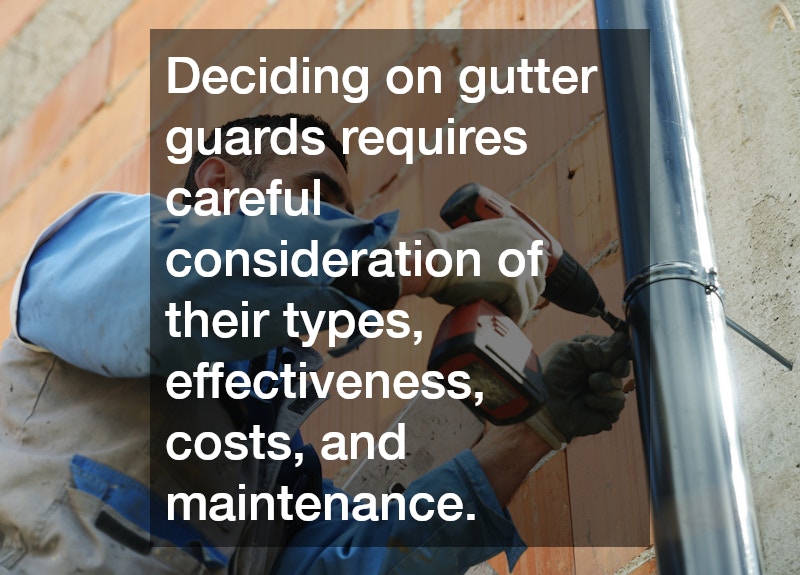Gutter guards have become a popular consideration for maintaining the integrity of your home. Knowing the benefits, costs, types, and maintenance requirements is essential for making an informed decision.
What Are Gutter Guards and How Do They Work?
Types of Gutter Guards
Gutter guards come in several types, each designed to address different needs and preferences. The most common types of gutter guards include mesh guards, reverse curve guards, and brush guards.
Mesh guards rely on a fine mesh that prevents debris from entering the gutters while allowing water to flow through. Reverse curve guards are designed to direct water into the gutter while forcing debris to fall to the ground.
Brush guards, on the other hand, use bristles to catch debris while allowing water to seep through. Each type has its unique advantages, making it crucial to evaluate them based on the specific conditions of your home environment.
Functionality
Gutter guards’ fundamental purpose is to prevent leaves, twigs, and other debris from clogging gutters. By doing so, they ensure that rainwater can flow freely into downspouts and away from your property.
They act as a barrier, allowing only water to enter the gutters, which helps in minimizing blockages. This functionality is particularly critical in areas with heavy foliage or frequent rainstorms.
For homeowners looking to take matters into their own hands, understanding how to install gutter guards properly can help maximize their effectiveness.
Ultimately, the goal is to enhance the drainage efficiency of your gutter system and reduce the risk of water damage to your home. While they aren’t infallible, their design greatly diminishes the frequency and intensity of clogs.
Do Gutter Guards Really Work?
Effectiveness
The effectiveness of gutter guards varies based on several factors, including the specific type of guard and the environmental conditions where your home is situated. In regions with mild weather, gutter guards perform exceptionally well in minimizing maintenance routines.
However, their effectiveness can be challenged by extreme weather conditions or an abundance of large trees nearby. For instance, in snowy climates, some gutter guards might struggle against ice dams.
Despite these challenges, many homeowners report a significant decrease in the time spent cleaning gutters after installation. The benefit is most pronounced during autumn when leaf fall is at its peak.
Limitations
While gutter guards greatly reduce debris accumulation, they aren’t entirely maintenance-free. Small particles such as shingle grit or seeds might still penetrate the guards, necessitating occasional cleaning.
Moreover, during periods of heavy snowfall, certain types of gutter guards may become overwhelmed, leading to blockages or ice dams. For this reason, it’s important to select a gutter guard system that’s appropriate for your local climate conditions.
Modifications might be necessary to ensure optimal guard performance in cases where roof pitch or gutter design complicate water flow. Understanding these limitations helps set realistic expectations and aids in making a well-informed decision.
What Are the Costs Involved?
Initial Costs
The initial investment for gutter guards can vary widely depending on the type, brand, and quality of the guards you choose. Mesh guards are generally the most affordable, while reverse curve guards can be significantly more expensive.
Installation costs are another consideration, as professionally installed systems will inevitably cost more than DIY options. It’s important to balance these initial costs against the potential benefits offered by the guards.
For many homeowners, the upfront expense is justified by the long-term savings on maintenance and potential damage repair costs. An investment in high-quality gutter guards can lead to a lower frequency of gutter cleanings, which can save money over time.
Long-term Value
In terms of value, the true worth of gutter guards lies in the protection and convenience they provide over time. They can prevent costly water damage to your home’s foundation, siding, or landscaping.
By minimizing the need for frequent cleanouts, these systems also free up valuable time, allowing homeowners to focus on other important tasks. Thus, while the initial cost may seem steep, the long-term savings and peace of mind can make the investment worthwhile.
When making your decision, consider the potential return on investment that gutter guards offer. In some scenarios, they might even increase your home’s resale value due to the enhanced maintenance and longevity of the drainage system.
How to Maintain Gutter Guards?
Cleaning and Upkeep
Despite their effectiveness, gutter guards still require periodic maintenance to ensure continued functionality. Regular inspections and cleanings can prevent any minor blockages from becoming significant issues.
Cleaning involves removing any accumulated debris from the guard’s surface and checking for damage or wear. Depending on the type of guard used, some may be easier to clean than others.
Seasonal Checks
Conducting seasonal checks of your gutter guards is essential to maintain their efficiency year-round. In the fall, this involves ensuring all fallen leaves are kept clear from the guards to maintain optimal water flow.
Winter brings its own challenges, such as ice build-up, which may require additional measures to prevent blockages. Spring and summer are ideal for ensuring that any new plant growth doesn’t interfere with the guards.
Deciding on gutter guards requires careful consideration of their types, effectiveness, costs, and maintenance. By understanding these aspects, homeowners can make a well-informed decision to protect their property efficiently.

